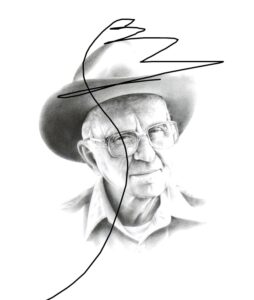Penn’s Treaty with the Indians by Edward Hicks

Edward Hicks, Penn’s Treaty with the Indians, ca. 1840, Oil on canvas, 36 x 48 inches, Courtesy of the Seraphin Gallery.
The Museum recently installed a new work in the galleries, Penn’s Treaty with the Indians, by Edward Hicks. It is the largest known Treaty painting by Hicks. For this work (created around 1840), Hicks followed the composition of an oil painting based on Benjamin West’s famous 1771-1772 depiction of the event.
For Edward Hicks, a devout Quaker, painting was a means to achieve the spiritual peace he so highly prized. Hicks earned little from his preaching so he also painted in order to earn “an honest living.” Trained as a coach and sign painter, Hicks achieved immediate success in his field. Although Hicks lacked formal training as an artist, he taught himself by copying earlier paintings or etchings, the same manner used by many academies at the time.
Typically, Hicks painted in oil on wood or canvas and specialized in Biblical scenes. The Peaceable Kingdom was based on a verse in the book of Isaiah. This theme of the “peaceable kingdom” expressed his Quaker belief in mankind’s ability to live together harmoniously. He repeated the theme often, painting over 60 versions of The Peaceable Kingdom. Hicks often painted his peaceful gatherings of animals and children in a landscape. In the distance he included a vignette of William Penn offering a treaty to the Native Americans. His style was naive, with realistic details in the animals and humans but the perspective was not accurate.

Edward Hicks also painted key events in American history, including Washington Crossing the Delaware and the Declaration of Independence. His most famous was Penn’s Treaty with the Indians. He painted several versions of this event; some examples can be found at the Philadelphia Museum of Art, the National Gallery of Art and The Museum of Fine Arts, Houston (pictured to the right). The event portrayed in Hicks’s Penn’s Treaty with the Indians refers to the arrival of William Penn in 1682 and his meeting with members of the Lenni Lenape tribe at Shackamaxon on the Delaware River to exchange gifts for land. Quakers viewed this meeting as a model of mutual consent, which they believed should rule future negotiations with the indigenous civilizations. In fact, Penn did meet with members of the Lenape tribe, but no documentation of a treaty exists.
To learn more about Edward Hicks, visit the Bucks County Artists Database.
Visit the Michener’s mobile app and the Google Art Project to learn more about The Portrait of Edward Hicks by his cousin, Thomas Hicks, in the Michener Art Museum’s permanent collection.